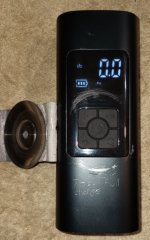So I run front/rear dash cams in both of my cars. My Honda Fit got clipped in the street and obviously no one left a note AND my dash cam didn't catch it! The camera was set for a whopping 6 hours of recording after being parked. So I went into the menu and set the dash cam to record up to 24 hours while parked. To pull this off I had to lower the recording voltage to cut-out at 11 volts. I go to start the car after sitting a few days and I have a dead battery. I check it with a volt meter and guess what, it was at 11 volts. So...
I pull the old school AMG lead-acid jump box out of the hatch and the voltage was to low to jump the car. I forgot to plug it in every 3 to 6 months so it can "condition" the battery. Okay, I have a lithium jump box in the Subaru.
I go grab that one and hook it up to the Fit battery. It runs a quick diagnostic, says 11 volts detected and ask it I want to jump it. I press the jump button and the Fit starts right up. I immediately pull the lithium jump box off the Fit and it almost instantly swells to twice it size, cracks it case open and gets toasty! Yeah, a lithium battery grenade! I stuck the jump box in a milk crate cage in the middle of the backyard until I can safely get rid of it! I paid $150 for that jump box (granted, 8 years ago) and this is the second time I used it! Yes, it was cold when I grabbed it but it was hooked up correctly according to the instructions.
So I go and charge the AMG lead-acid jump box and it wont take a charge over 3 out of 6 bars. It barely charges to 12 volts MAX. It also lost its wind-up power to jump a car. I paid roughly $180 for that jump box 4 years ago. I figured that the AMG jump box should have lasted for much longer. So now I have to look for my old jumper cables and beg for a jump if I need one.
I did change the dash cams in both cars to shutdown at 12.4 volts so they wont run my batteries down. These cars get driven very little and will sit for a minimum of a week for up to a month. The best part of this whole battery jump box drama? Both cars have very expensive Interstate batteries in them. But if you run any battery down to 11 volts your car wont start.
Anyone have good luck with portable jump boxes? I'll list the brands when I get to them as the one is in milk crate jail and the other is in the garage right now.
I pull the old school AMG lead-acid jump box out of the hatch and the voltage was to low to jump the car. I forgot to plug it in every 3 to 6 months so it can "condition" the battery. Okay, I have a lithium jump box in the Subaru.
I go grab that one and hook it up to the Fit battery. It runs a quick diagnostic, says 11 volts detected and ask it I want to jump it. I press the jump button and the Fit starts right up. I immediately pull the lithium jump box off the Fit and it almost instantly swells to twice it size, cracks it case open and gets toasty! Yeah, a lithium battery grenade! I stuck the jump box in a milk crate cage in the middle of the backyard until I can safely get rid of it! I paid $150 for that jump box (granted, 8 years ago) and this is the second time I used it! Yes, it was cold when I grabbed it but it was hooked up correctly according to the instructions.
So I go and charge the AMG lead-acid jump box and it wont take a charge over 3 out of 6 bars. It barely charges to 12 volts MAX. It also lost its wind-up power to jump a car. I paid roughly $180 for that jump box 4 years ago. I figured that the AMG jump box should have lasted for much longer. So now I have to look for my old jumper cables and beg for a jump if I need one.
I did change the dash cams in both cars to shutdown at 12.4 volts so they wont run my batteries down. These cars get driven very little and will sit for a minimum of a week for up to a month. The best part of this whole battery jump box drama? Both cars have very expensive Interstate batteries in them. But if you run any battery down to 11 volts your car wont start.
Anyone have good luck with portable jump boxes? I'll list the brands when I get to them as the one is in milk crate jail and the other is in the garage right now.

